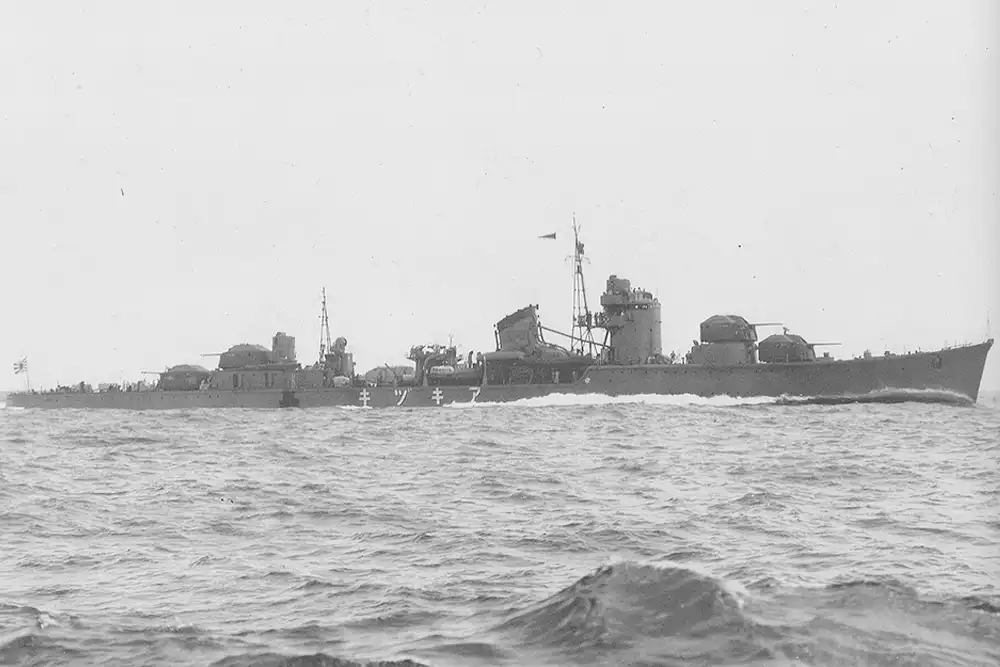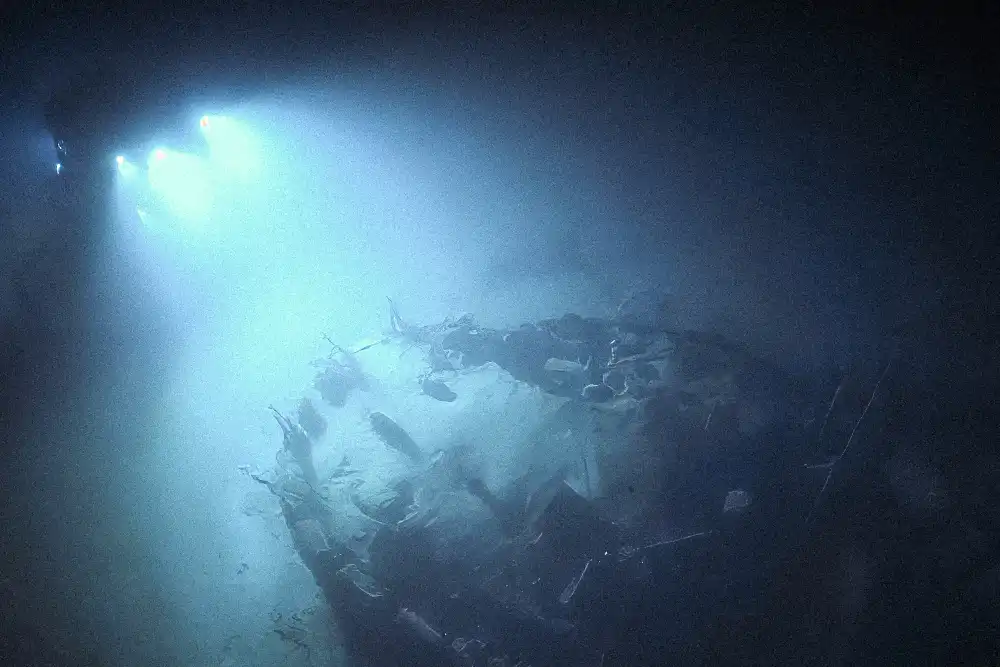
The wreckage of the Second World Conflict Imperial Japanese Navy destroyer Teruzuki has been found within the Solomon Islands, 83 years after she was sunk by American torpedo patrol boats.
The ship was positioned by a staff of scientists on board the Ocean Exploration Belief (OET)’s Exploration Vessel Nautilus at a depth of 800 meters in Iron Backside Sound – the title bestowed on a stretch of water within the Solomon Islands for the sheer quantity of ships and plane sunk there through the Pacific naval battles.
The staff used remotely operated autos (ROVs) Hercules and Atalanta to analyze a goal beforehand discovered throughout seafloor mapping operations by the College of New Hampshire’s uncrewed floor vessel (USV) DriX.
Particulars from the survey have rewritten the commonly accepted story of Teruzuki’s destiny, because the reported method of her sinking as a result of an explosion in her depth cost journal seems to have been disproved by footage of the strict part recorded by the ROVs.

Teruzuki – 照月 in Japanese Kanji, which interprets as ‘shining moon’ – was a 134 metre-long Akizuki-class destroyer, certainly one of 13 constructed for the Imperial Japanese Navy (IJN) between 1940-1945.
Akizuki (秋月, that means ‘Autumn’) have been designed primarily as anti-aircraft escorts for plane carriers but additionally carried torpedoes and depth expenses along with their batteries of dual-purpose weapons, making them efficient multi-purpose vessels.
Laid down on the Mitsubishi shipyard in Nagasaki in November 1940 and accomplished in August 1942, Teruzuki would serve lower than 4 months earlier than being sunk in December 1942 through the Battle of Guadalcanal.
Guadalcanal – the most important of the Solomon Islands – was the scene of among the most devastating Naval battle of the Second World Conflict, as Japanese and American forces fought for management of the strategically necessary island between August 1942 and February 1943.


Teruzuki had been present process repairs on the Imperial Navy’s base in Chuuk Lagoon when she was ordered to hitch the Japanese ‘Vanguard Power’ in November 1942.
Throughout the Naval Battle of Guadalcanal between 12 to fifteen November, Teruzuki was instrumental within the sinking of two US destroyers, Laffey and Monssen, and disabling no less than two others,
Cushing and Sterett, earlier than the Japanese ships have been compelled to withdraw.
Teruzuki returned to Chuuk and was appointed because the flagship of Rear Admiral Raizou Tanaka, a extremely revered sailor nicknamed ‘Tenacious Tanaka’ by US forces for his nighttime assaults and torpedo experience.
4 months into the Guadalcanal marketing campaign, the Japanese troops stationed on the island have been in determined want of provides, however US forces have been profitable in stopping the IJN’s ships from touchdown.

Nicknamed the ‘Tokyo Categorical’, Tanaka’s ships delivered provides at excessive pace through the evening, dropping sealed metal containers into the water within the hope they’d drift in the direction of shore with the present.
On 11 December, Teruzuki was tasked with escorting a convoy despatched to resupply Japanese troops on Guadalcanal’s northern coast.
The convoy survived an assault by US bombers, however shortly after dropping their provides, they have been intercepted by American PT boats – quick patrol torpedo assault boats – and Teruzuki was struck twice in her stern at round 1.20 within the morning.
The explosion smashed Teruzuki’s rudder and broken certainly one of her prop shafts, leaving her disabled as fireplace broke out in a ruptured oil tank. Many of the crew have been both rescued or have been in a position to swim to shore, nevertheless, 9 males of her 353-man crew have been killed through the assault.

It has been beforehand accepted that Teruzuki sank when fireplace unfold to her depth cost journal, triggering an explosion which severed the hull.
Throughout the OET surveys, nevertheless, the exploration staff discovered a 19-meter-long severed phase of Teruzuki’s stern roughly 200 metres from the remainder of the ship, nonetheless suffering from intact depth expenses.
The staff says the discovering disproves the long-held concept that it was depth cost explosions that brought about the ship to sink, indicating that it was the American torpedoes which sealed Teruzuki’s destiny.
‘I really feel so fortunate to see this ship. The truth that we have now not seen Teruzuki in over 80 years underscores the significance of recording maritime heritage now,’ mentioned Hiroshi Ishii, Nautilus science staff member and Researcher on the Centre for Southeast Asian Research at Kyoto College.
‘As a Japanese particular person, I recognize the chance to witness a part of our historical past and to be a part of a world staff shedding mild on this marketing campaign, which is necessary to all of our nations’ historical past.’

‘The invention of Rear Admiral Tanaka’s flagship Teruzuki was made by a multidisciplinary, worldwide staff who collectively documented its stays, uncovering Teruzuki’s significance to former combatant, and now allied, nations,’ mentioned Phil Hartmeyer, marine archaeologist from NOAA Ocean Exploration.
‘Solely by exploring our planet’s unknown waters can these important tales of sacrifice and human connection to our ocean be delivered to mild.’
Associated articles
Teruzuki’s discovery is from an ongoing expedition to discover Iron Backside Sound led by OET and supported by NOAA Ocean Exploration through the Ocean Exploration Cooperative Institute. The surveys are streamed stay on NautilusLive.org, and oyou can comply with the staff on Instagram @nautiluslive and Fb @nautiluslive.

